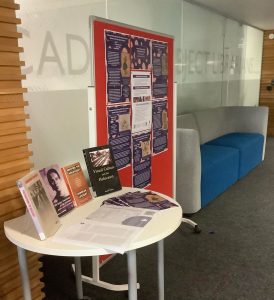By Olivia Hennessey (3rd year student, Chair of University of Lincoln’s Students Equality, Diversity and Inclusion Committee in the School of Humanities and Heritage). Olivia is regional ambassador for The Holocaust Educational Trust

‘We will continue to do our bit for as long as we can, secure in the knowledge that others will continue to light a candle long after us’- Gena Turgel MBE, survivor of the Holocaust (1923-2018)
Every year on January 27th, people gather to remember the six million Jews and other minorities who were murdered in the Holocaust by the Nazi regime and their collaborators, as well as the genocides that followed in Cambodia, Rwanda, Bosnia, and Darfur. On this day in 1945, Soviet soldiers liberated the Auschwitz concentration camp, but there were still more camps to be liberated; the last camp, Stutthof, was liberated on May 9, 1945.
This year’s theme is Ordinary People, which highlights the facet that we must look beyond the numbers and recognise that those who perished or survived, even perpetrators and bystanders, were ordinary people. As an East Midlands Regional Ambassador for the Holocaust Educational Trust, the aim of this blog post is to share the knowledge of those who were involved and fell victim to the past and present atrocities; to make sure that history does not repeat itself. I am involved in a fantastic social media campaign (set up by Phoebe who is a fantastic Regional Ambassador) called #HMDBeyondTheNumbers, where we have been posting names and stories of the victims of the Holocaust who were just ordinary, and their lives were stolen from them. Each of us found individuals that we have in common with, be it a hobby, a name or a birthday, aiming to remind people of the humanity of Holocaust victims. In particular, I will be sharing women artists during the Holocaust where their lives and works are on the university library display board.
Charlotte Burešová (1904–1983)
Burešová began painting portraits, still lives, and flowers at a young age. She did not exhibit her works, instead giving them as gifts to her friends. Burešová married a non-Jewish lawyer when she was young and had a son, but when the Germans occupied Czechoslovakia, she divorced her husband to avoid the decrees against Jews affecting her family.
She was imprisoned in Theresienstadt in July 1942 and forced to work in a specialised workshop, painting tiles for the Germans. Buresova was then sent to the artists’ workshop, where she painted copies of works by classical masters such as Rubens and Rembrandt under the supervision of Germans. She created works that were not commissioned by the Germans in pencil, crayon, chalk, watercolours, and oils.
A German officer, impressed by Buresova’s artistic talent, intervened to prevent her deportation. He commissioned her to paint the Virgin Mary, which she did with a tear in the Madonna’s eye. When the officer saw it, he was very impressed and told her not to finish the painting. She would not be deported to the East as long as she worked on it.
Malva Schaleck (1882–1944)
Malva relocated to Munich and spent a year studying art at the Women’s Academy (Frauenakademie). She then relocated to Vienna and opened a studio. While in Vienna, Schaleck established a reputation as a portrait painter, with the majority of her subjects being middle and upper-class Jews.
After the Anschluss (the Anschluss of Austria to Germany) in March 1938 and the Nazis’ introduction of antisemitic laws, Malva fled Vienna, leaving all her works in her studio.
Schaleck was deported to Theresienstadt in 1942, where she painted scenes of ghetto life. Her pencil, charcoal, and watercolour works were hidden in building walls and discovered after the liberation. They bear faithful witness to various aspects of life in the Theresienstadt ghetto-camp.
Malva Schaleck was deported to Auschwitz on May 18, 1944, for refusing to draw a collaborator physician. She was killed there. Her niece and nephew, Lisa Fittko and Hans Eckstein, as well as David Ziskind and Moshe Knobloch, donated a large number of Schaleck’s works to the Ghetto Fighters’ House Museum.
By considering these artists and hearing and sharing survivor testimonies, this has shed the light on the Holocaust and recent genocides. These have been painful for survivors to share, so their bravery and past will never be forgotten. Even in the present, there are modern atrocities happening. For example, the ongoing treatment of Uyghur Muslims. This must not be left unchallenged, so using our voices and increasing our knowledge will shine a light on the situation and address those who are responsible.
There are many ways to share the lives of ordinary people. It is important to educate others; previous generations, our generations and future generations about the atrocities that happened before, during and after these genocides.
References
Yad Yashem: The World Holocaust Remembrance Center (2023) Charlotte Burešová, women artists in the holocaust. Israel: Yad Vashem. Available from https://www.yadvashem.org/museum/museum-complex/art/online-exhibitions/women/charlotte-buresova.html [accessed 19th January 2022]
Yad Yashem: The World Holocaust Remembrance Center (2023) Malva Schalek, women artists in the holocaust. Jerusalem: Israel: Yad Vashem. Available from https://www.yadvashem.org/museum/museum-complex/art/online-exhibitions/women/malva-schalek.html [accessed 19th January 2022]
Jewish Women’s Archive (2023) Pnina Rosenberg, art during the holocaust. Auburndale, USA: Jewish Women’s Archive https://jwa.org/encyclopedia/article/art-during-holocaust [Accessed 19th January 2022]